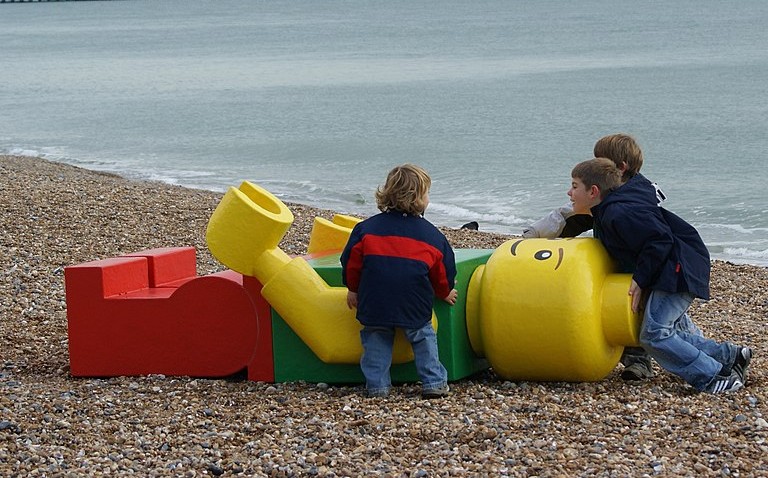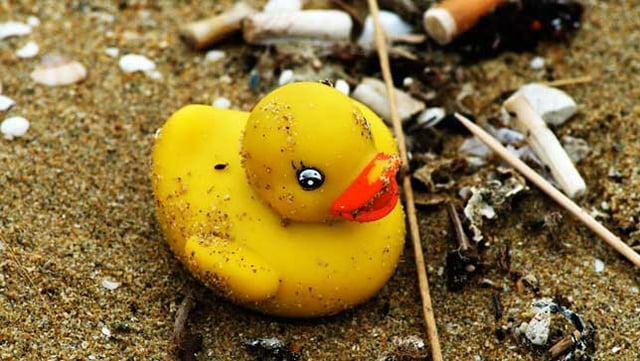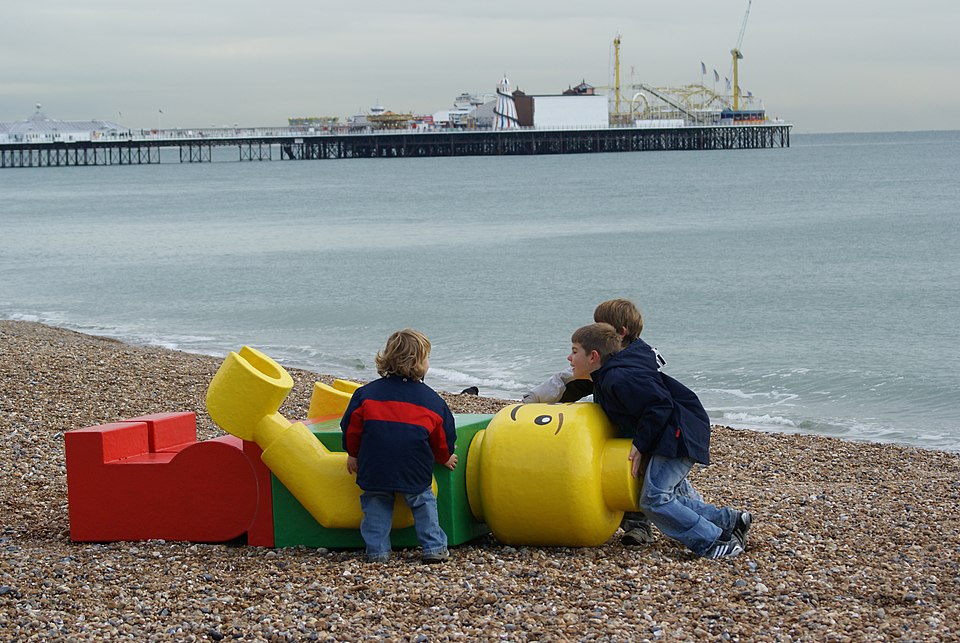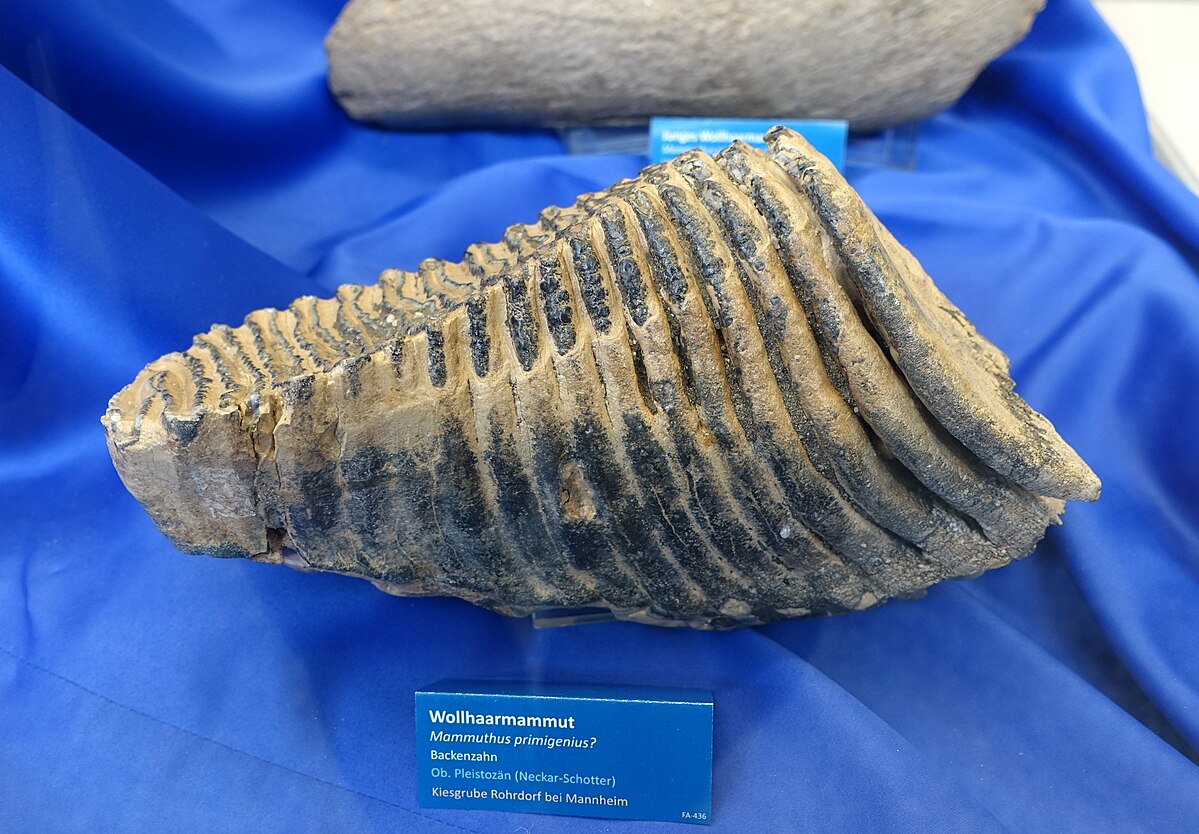
A motorcycle traveled 4,000 miles across the Pacific Ocean and still found its way back to its owner. That’s not even the strangest part of this story.
The ocean is essentially a massive, unpredictable delivery service that’s been operating without customer service for millions of years. It picks up items from one continent and drops them off on another, often decades later, with no tracking number and zero regard for whether you actually ordered a 6-foot Lego man or a century-old block of Indonesian rubber.
Here are some of the most bizarre items that have made this one-way journey to our shores.
In February 2023, beachgoers in Japan spotted a large, rusty sphere that looked like it had rolled straight out of a science fiction movie. The 5-foot-wide yellowish ball sparked immediate panic—was it a mine? A surveillance device? An alien egg?
Social media went wild with theories before police stepped in with X-ray equipment. The verdict? A perfectly ordinary mooring buoy. Sometimes the most mundane explanation is the right one, even when your brain desperately wants it to be something from another planet.
For over three decades, residents along France’s Brittany coast found fragments of orange landline telephones shaped like everyone’s favorite lasagna-loving cat. The phones kept washing up year after year, becoming a local legend that stumped marine biologists and Garfield fans alike.
The mystery was finally solved in 2019 when the source was discovered: a shipping container wedged deep inside a sea cave, accessible only at low tide. For 35 years, this container had been slowly releasing its cargo of novelty phones, one storm at a time. The persistence of plastic in marine environments means that single shipping accident in the 1980s was still delivering “mail” well into the Instagram era.
Ikuo Yokohama’s motorcycle didn’t just survive the 2011 Japanese tsunami—it embarked on an epic 4,000-mile journey across the Pacific. When it washed up on Graham Island in western Canada a year later, it still had visible identification numbers that allowed authorities to trace it back to its owner.
This wasn’t just any debris. It became a symbol of the tsunami’s incredible reach, demonstrating how natural disasters can scatter personal belongings across entire ocean basins. The motorcycle’s journey took longer than most people’s round-the-world trips, but it arrived with a story no travel blogger could match.
Sometimes the ocean’s random delivery service accidentally advances human knowledge. In 1992, a cargo ship lost 29,000 plastic bath toys—yellow ducks, green frogs, blue turtles, and red beavers—into the Pacific Ocean. These “Friendly Floatees” became the world’s cutest oceanographic research project.
Scientists have been tracking these toys for over three decades as they bobbed around the globe, washing up everywhere from Hawaii to the Arctic. The toys revealed previously unknown patterns in ocean currents and helped researchers understand how the ocean’s conveyor belt system really works. Who knew that rubber ducks could be better at mapping ocean currents than million-dollar equipment?

In 2011, a baby grand piano appeared on a Miami sandbar like some fever dream of a classical musician. The charred instrument sat in the middle of Biscayne Bay, turning pelican roosts into impromptu concerts and launching a thousand conspiracy theories.
The truth behind the mysterious piano was both more mundane and more elaborate than anyone expected. Nicholas Harrington, a 16-year-old with artistic ambitions, had rescued the instrument from his grandmother’s garage where it had sat for four years as an old movie prop from his father’s TV production work. After New Year’s revelers burned it to tatters at a party, Harrington saw opportunity in the wreckage.
On January 2nd, he and his brother loaded the destroyed piano onto their family’s 22-foot boat and placed it on the highest spot of a sandbar, hoping to create what he called “a whimsical, surreal experience” for passing boaters. His inspiration? Artist Christo’s famous 1980s installation where he draped 11 Biscayne Bay islands in hot pink fabric. The teenager wanted to leave his own mark on Miami’s seascape, and if it helped him get into Manhattan’s Cooper Union college, even better.
When retired postal worker Marianne Winkler spotted a clear bottle during her beach vacation on the German island of Amrum, she discovered the ocean’s commitment to extremely delayed mail delivery. The bottle contained a 108-year-old postcard with instructions in bold red letters: “BREAK THE BOTTLE.”
After unsuccessful attempts to open it without breaking the glass, the Winklers followed orders. Inside was a multilingual postcard from the Marine Biological Association asking finders to report where and when they’d discovered the bottle, with the promise of “one shiny shilling” as reward. This wasn’t some romantic message from a lovelorn sailor—it was part of a massive 1906 scientific experiment by researcher George Parker Bidder, who released 1,020 bottles to track bottom water currents and fish migration patterns.
Here’s where Victorian-era customer service puts modern companies to shame: when the MBA received the Winklers’ report in 2015, they didn’t just acknowledge it with an automated email. They hunted down a period English shilling on eBay and mailed it to Germany, honoring a promise made before the Wright brothers had figured out powered flight. The bottle had traveled over 600 nautical miles in 108 years, making it the oldest confirmed message in a bottle on record.
Occasionally, the ocean delivers visitors from its deepest neighborhoods. Giant oarfish, which normally live 3,000 feet below the surface, sometimes wash up on beaches looking like something from ancient sea monster legends. These ribbon-like fish can reach 30 feet in length and are likely the real-world inspiration for countless “sea serpent” tales.
In Japan, they’re called “Messenger of the Sea God” and are thought to predict earthquakes, though scientists remain skeptical about their prophetic abilities. More likely, these deep-sea dwellers surface when they’re sick or dying, unable to handle the pressure changes of shallow water.

Between 2007 and 2015, a 6-foot-tall Lego minifigure mysteriously appeared on beaches across four continents. The figure wore a green shirt with the cryptic message “No Real Than You Are” and was signed by someone called “Ego Leonard.”
This turned out to be an elaborate guerrilla art project by Dutch artist Leon Keer, who was using the ocean as his global gallery space. The recurring appearances of “Ego Leonard” transformed random beach discoveries into philosophical statements about reality and artificiality, proving that sometimes the strangest finds are intentionally strange.
The ocean doesn’t just transport modern oddities—it’s also an archive service for prehistoric items. Woolly mammoth teeth regularly wash up on beaches worldwide, evidence that these massive creatures once roamed areas now buried beneath the sea.

These molars, some over 100,000 years old, emerge from underwater deposits when storms and currents erode the seafloor. Finding one is like receiving a postcard from the Ice Age, a tangible connection to a world that existed long before humans were around to lose shipping containers full of rubber ducks.
Every strange beach discovery tells two stories: the obvious one about the object itself, and the hidden one about the incredible forces that brought it there. Ocean currents can carry items thousands of miles, storms can uncover artifacts buried for centuries, and human activity creates an endless supply of accidental maritime mail.
The next time you’re walking along the shore, remember that you’re essentially browsing through the ocean’s lost and found department—one that’s been collecting items for millions of years and has absolutely no intention of getting organized. Whether you’re identifying mysterious objects with your phone camera using apps like What Is This Thing or just enjoying the mystery, every beach holds the potential for discovery.
After all, somewhere out there, the ocean is preparing your next delivery. You just never know if it’ll be a century-old message in a bottle or a confused deep-sea creature looking for directions home.
Download the What Is This Thing app and identify anything with a single photo.